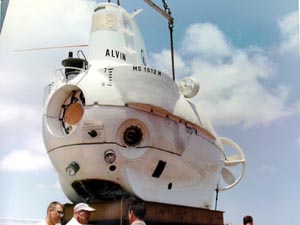|
Photos
Your Voice
|
General Mills celebrates 75 years of innovation
July 10, 2003
 |
| In the 1960s, General Mills designed a small, deep-diving submarine for the US Navy, nicknamed Alvin. (Photo courtesy of Harold Froehlich) |
Golden Valley, Minn. — General Mills is best known as a food company. But the company has left footprints in a broad range of non-food industries.
In the 1960s and '70s, General Mills acquired FootJoy, Kenner Products and Parker Brothers, Eddie Bauer and Talbots. In 1924 General Mills' predecessor firm, the Washburn Crosby Company, bought Minneapolis radio station WLAG, and renamed it WCCO. The station allowed the company to try new marketing ideas like the first singing commercial, and Betty Crocker's first cooking show.
 | |||
General Mills Vice President of Research and Development Lisa Schroeder says the company's early food innovations built a platform for new ideas in other areas.
"In the late 1800s we were a flour milling company. We then began to figure out what we wanted to really be involved in, and that was food. In the early '20s we developed Wheaties, and then we kept going [with] Bisquick," Schroeder recounts. "Cheerios came out in the '40s, but we were also figuring out, well, how do you make those? There's a lot of great engineering and great process development that goes into that, and out of that came a mechanical division.
With the University of Minnesota, General Mills developed the Ryan Flight Recorder, now known as the "black box" that records aircraft flight data.
General Mills also made mechanical arms, and adapted them for the Trieste, a deep-sea submarine. That led General Mills briefly into the submarine business.
"In 1962, on a contract from the United States Navy, we were commissioned to build a small, deep-diving submarine," Schroeder says. "We did that, and that sub was named Alvin, and it was later used to take the first pictures of the Titanic on the ocean floor."
 | |||
Alvin's design and assembly took place in Minneapolis.
"The Bureau of Ships was skeptical about a Wheaties company designing a submarine. They really didn't want to see this precedent set," says engineer Harold Froehlich.
Known by his nickname Bud, and now 80, Froehlich came up with the design that eventually became Alvin, despite Navy skepticism.
 | |||
"This H-bomb being lost off the coast of Spain is really what changed their mind completely. They found that Alvin could be a very useful thing," says Froehlich.
Alvin was stationed at the Woods Hole Oceanographic Institution on Cape Cod, and certified for deep dives in 1965. Six months later, a B-52 carrying four unarmed hydrogen bombs collided with a tanker while refueling in midair. One of the bombs landed in deep water in the Mediterranean.
"This was at the height of the Cold War," says Froehlich. "Russian ships converged on the area, and the Navy converged on the area. And the Navy called Woods Hole and said, 'We need Alvin to find this thing.' It was the only vessel available at the time that the Navy could possibly use."
After a lengthy search Alvin located the bomb, and it came to the surface April 7.
The next year in the Bahamas, Alvin came under attack in about 2,000 feet of water. Alvin prevailed over its assailant, a swordfish, whose sword got stuck in the sub's outer skin.
"The crew brought the swordfish back to the surface, and arranged for a local restaurant to cut it up, and they had it for dinner that night. It was a fairly good sized one, too," Froehlich says.
General Mills sold the division that made Alvin before it was finished, and eventually got out of shoes, clothing, and other industries as well. The company is sticking to food now, and bought its former neighbor and rival, Pillsbury, in 2001.
Alvin shares one thing with other General Mills innovations -- longevity. Like Wheaties, Cheerios and Betty Crocker, it's still going -- albeit with a few upgrades -- decades after its launch.
|
News Headlines
|
Related Subjects
|
